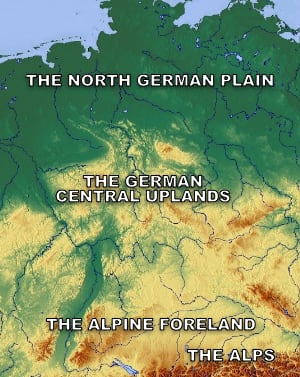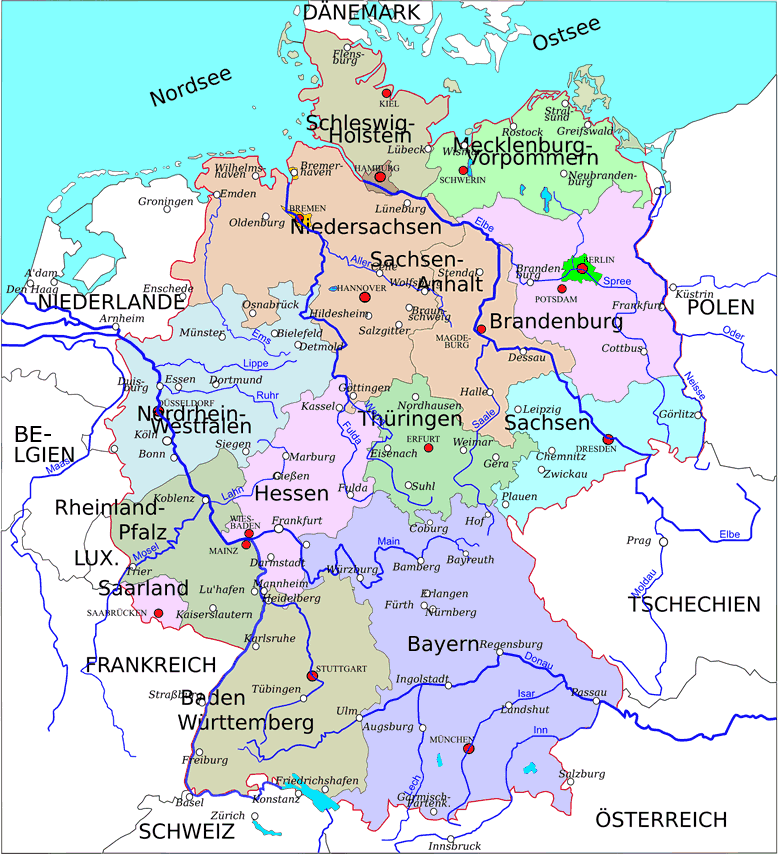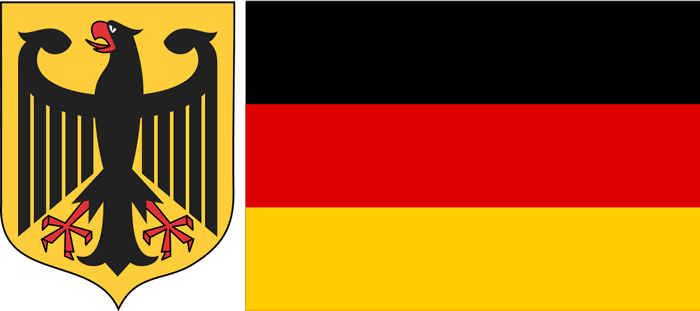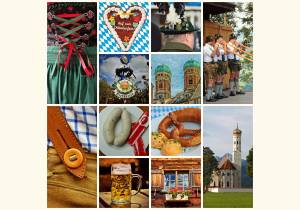Information about Germany and the Germans: geographical, political, economic and social situation and structure of the country; languages and peoples, climate, traditions
This page offers a general description of Germany and the residents of the country containing interesting details and facts. Due to this information, you will get a chance to get to know Germany and the Germans - this is undoubtedly important for everyone who lives in Germany or would like to live, work or do business in this country.
- Information on the page:
- Brief overview about Germany
- Geographical position of Germany
- Nature of Germany: flora and fauna
- Climate, weather in Germany
- Map of Germany
- German economy
- Political structure of Germany
- Social(Welfare) state of Germany
- Population of Germany
- Languages and peoples of Germany
- Religions of Germany
- Traditional food, drinks in Germany
- Traditional German clothing
- Famous people of Germany
- Sports and entertainment in Germany
- Comments and questions
§ Brief information about Germany
The basic data on Germany discussed on this page are summarized in table 1 below.
| Indicator | Value |
|---|---|
| Territory | 357'578.17 km2 |
| Population | 84.4 million people as of 2022 |
| Number of German residents with immigrant background | 24 % |
| Capital of Germany | Berlin |
| Bordering countries | Denmark, Poland, the Czech Republic, Austria, Switzerland, France, Luxembourg, Belgium, the Netherlands |
| Length of borders | 3'876 km. |
| Number of types of vegetation | 10'000 species |
| Number of animal species | 48'000 species |
| Climatic zone | Moderate |
| Average annual air temperature | 10.6 °C as of 2023 |
| Currency | Euro |
| German GDP | 3,3 trillion euros as of 2017 |
| Economic system | Socially oriented market economy |
| Political regime | Democracy |
| Form of government | Federal Republic |
| Social system | Social state |
| Official language | German, there are numerous dialects |
| Most important religion | Christianity |
| Most popular sport | Football |
| Number of public holidays per year | Ranging from 11 to 18 |
§ Geographical position of Germany, landscape of the country
Germany is the middle-largest country in the center of Europe; Germany borders on the following 9 countries:
- In the north: Denmark
- In the east: Poland, the Czech Republic
- In the south: Austria, Switzerland
- In the west: France, Luxembourg, Belgium, the Netherlands
Compared to Russia, the largest country in the world, Germany is approximately 50 times smaller in area. However, the landscape of Germany is very diverse. There are 4 regions of Germany with a diverse landscape, from north to south of the country.

The North German Plain or Northern Lowland (in German: Norddeutsches Tiefland)
The North German Plain is located in the northern part of Germany, stretching from the coast of the North and Baltic Seas, which wash Germany, to the mid part of Germany. In the eastern part of the Lowland there are many lakes, while in the western part there are mainly fields, meadows and swamps (most of which have already been drained).
The German Central Uplands (in German: Mittelgebirgsschwelle)
In the central part of Germany, there are the German Central Uplands or the Mittelgebirgsschwelle; for the most part they are covered with fir and beech forests.
The German Central Uplands include:
- The Bavarian Forest mountain range (in German: Bayerischer Wald),
- The Ore Mountains (in German: Erzgebirge),
- The Harz Mountains (in German: Harz),
- The Taunus mountain range (in German: Taunus),
- The Eifel Uplands (hill range) (in German:Eifel),
- The Swabian Jura mountain range (in German: Schwäbische Alb),
- The Rhön Mountains (in German: Rhön),
- and some others.
In the Rhön and Eifel Mountains there are some extinct volcanoes.
The Alpine Foreland, the Bavarian plateau
Further south of Germany, between the German Central Uplands and the Alps there lies the Alpine Foreland, with relatively flat, hilly land, covered with coniferous forests, as well as many large and small lakes. The most famous and beautiful lakes in this region are as follows:
- Lake Chiemsee (in German: Chiemsee);
- Lake Starnberg (in German: Starnberger See);
- The Ammersee, Lake Ammer (in German: Ammersee);
- The Walchensee, Lake Walchen (in German: Walchensee);
- The Kochelsee, Lake Kochel (in German: Kochelsee);
The Alps
The Alps are the largest mountain range in Europe; part of this range, which is located on the territory of Germany, is called the Northern Limestone Alps, also known as the Northern Calcareous Alps (in German: Nördliche Kalkalpen).
Rivers of Germany
There are many rivers in Germany; the table below features the main rivers of Germany.
| Name of the river in German | Name of the river in English | Length of the river on the territory of Germany, km |
|---|---|---|
| Donau | Danube | 647 |
| Rhein | Rhine | 865 |
| Elbe | 727 | |
| Oder | 179 | |
| Weser | 750 | |
| Mosel | Moselle | 242 |
| Main | 569 | |
| Inn | 218 | |
| Saale | 413 | |
| Spree | 382 | |
| Ems | 371 | |
| Neckar | 384 | |
| Havel | 560 | |
| Werra | 292 | |
| Isar | 263 | |
| Mulde | 290 | |
| Leine | 281 | |
| Lech | 170 | |
| Aller | 346 | |
| Weiße Elster | 247 | |
| Lahn | 250 | |
| Altmühl | 220 | |
| Lippe | 268 | |
| Ruhr | 227 | |
| Fulda | 219 | |
| Elde | 208 | |
| Kocher | 201 |
§ Nature of Germany: flora and fauna
Germany is located in the temperate climatic zone, it is neither very cold, nor very hot here all year round, there is a lot of rain, which is a great place for many species of animals and plants that can be found in Germany. Besides, the landscape of Germany from north to south is very diverse, it includes wetlands, sea coasts, meadows, fields, forests, as well as mountains, many rivers and lakes, which also determines the diversity of the flora and fauna of Germany.
Plant life of Germany, flora of Germany
-

Drosera (in German: Sonnentau) - a carnivorous plant
The flora of Germany is represented by more than 10'000 species of trees, shrubs, flowers, herbs and other vegetation. A third part of the territory of Germany is covered with mixed forests: coniferous and deciduous trees. The main types of trees are: spruce, pine, beech trees and oaks. It is believed that the tallest tree in Germany is located in the forest of Freiburg (in German: Arboretum Freiburg-Günterstal), it is a Douglas fir or an Oregon pine, called "Waldtraut of the Mill Forest" (in German: Waldtraut vom Mühlwald) and is more than 66 meters high.
In the northern part of Germany, in marshy areas, which are not so many in the country, you can find rare species of plants and animals, for example, drosera (in German: Sonnentau) - a carnivorous plant.
Animal life of Germany, fauna of Germany
-

The golden eagle (in German: Steinadler)
-

European bisons or wisents (in German: Wisente)
The animal life of Germany is even more diverse than the plant life, with 48'000 species of insects, animals, birds, fish, and reptiles; 2/3 of the species are insects.
The largest animals in Germany are European bisons or wisents (in German: Wisente), reaching up to 3 meters in length and 2 meters in height. Besides, Germany is home to deer (in German: Rothirsch) and roe deer (in German: Rehe), wolves, foxes, wild cats and squirrels; harvest mice and hamsters live in the fields.
Germany is populated with many species of birds, especially: the golden eagle (in German: Steinadler), a very large bird of prey, hawks, storks, on the coast of the seas you can see many sea-gulls, and in populated localities there are thrushes, wagtails, chaffinches, jackdaws and, of course, sparrows, pigeons and magpies.
National parks and animal parks
In Germany, there are several hundred animal and bird parks, as well as botanic gardens where the visitors can admire animals and plants placed in their natural habitat. Below there is a list of popular parks and national reserves in Germany:
- Zoologischer Garten Berlin – a zoo in Berlin, 20'000 animals;
- Tierpark Hagenbeck Hamburg – the Hamburg zoo;
- Erlebnis Zoo Hannover – the Hanover zoo;
- Serengeti-Park Hodenhagen – the Serengeti Park in Hodenhagen;
- Weltvogelpark Walsrode - the world's largest bird park, 4,200 birds;
- Nationalpark Bayerischer Wald – the Bavarian Forest National Park;
- Nationalpark Eifel – the Eifel National Park;
- Nationalpark Harz – the Harz National Park;
- Nationalpark Sächsische Schweiz – the Saxon Switzerland National Park;
- Naturpark Thüringer Wald – the Thuringian Forest Nature Park;
§ Climate, weather in Germany
The climate in Germany is temperate, typical of Europe, however, due to the fact that Germany has different landscapes, the climate in the country varies accordingly.
The climate of the northern part of Germany is affected by the North and Baltic Seas, making it maritime with rainy summers, warm winters, and numerous storms. West Germany has a warm oceanic climate with rainy winters and warm summers, due to the influence of the Atlantic Ocean. In the east and southeast, there is a continental climate with hot summers and cold winters. The southwest part of Germany has a humid subtropical climate. The very south of Germany, in the Alpine Mountains, witnesses a typical mountain climate.
The average annual air temperature in Germany in 2023 made 10.6 degrees Celsius.
Average annual temperature, precipitation(rainfall) and sunny days in Germany
According to the German State Weather Service or Meteorological Service (Deutscher Wetterdienst), the average annual air temperature in Germany in 2023 made 10.6 degrees Celsius. The coldest month in Germany is January and the warmest one is July. In 2023, 1'753 hours of sunshine were recorded in Germany, and the amount of precipitation was 958 liters per 1 square meter.
You can find out more about the climate and weather in Germany on dedicated pages of our website:
- Characteristics and peculiar features of the climate in Germany
- The way the climate change is taking place in Germany
- Average air temperature in Germany by year, month, federated state
- Amount of rainfall in Germany by year, month, federated state
- Number of sunny days in Germany by year, month, federated state
§ Map of Germany
The map below shows the location of Germany in Europe and the countries bordering it. The German federated states are highlighted in different colours in the map. To view a map of the German federated states in English, go to a deicated page of our website.

§ German economy
Germany is one of the most economically developed and wealthy countries in the world. To compare the level of economic development of countries, the economic indicator of the GDP or the Gross Domestic Product (in German: Bruttoinlandsprodukt) is used; this indicator represents the value of all goods and services produced in the country during the year. Germany's GDP as of 2017 amounted to approximately 3.3 trillion euros, so Germany ranks fourth in the world in terms of this economic indicator after China, the USA and Japan. Industrial production and exports play the largest role in the country's economy. Most businesses in Germany are medium-sized firms with between 50 and 500 employees. Most of the country's population is engaged in services: transport, tourism, education, medicine, finance, and others.
The German economic system - is a socially oriented market economy in which free or perfect competition of enterprises in their supply of goods and services in the country's market plays an important role, however, the state, through the laws, regulates the economic relations in such a way as to ensure social protection for all its citizens and to avoid gross injustice in competition and income distribution.
The most important industries in Germany are as follows: automotive industry, mechanical engineering, chemical industry, and electrical engineering industry.
Germany is home to several of the world's most important chemical concerns; the largest chemical production in the world is owned by BASF and is located in the city of Ludwigshafen. The largest automotive companies are as follows: Volkswagen, Daimler and BMW.
Why is Germany's economy so strong?
Several of the following important factors make the German economy strong:
- Highly developed industrial production: automotive, chemical industries, mechanical engineering, and others.
- Germany is open to export and import of products, thus being a free trade country; it belongs to the top three countries that are the largest exporting countries in the world.
- In Germany, there are several metropolitan areas (Metropolitan areas and cities of Germany), which are also the main economic centers of the country.
- Besides, Germany has a very low unemployment rate. As of 2018, there are about 44 million working-age people in Germany, of whom only 3.2% are unemployed.
§ Political structure of Germany
The country of Germany is a federal republic: it includes 16 federated states, that have political independence in domestic policies, while remaining within the political and legal borders of the state or Federation per se. Thus, the political system of Germany includes the federal and regional levels, each of which has their own system of legislative, executive and judicial power.
Germany is a democratic state with avanced legal and social systems. The Basic Law of the country is the German Constitution, which defines the basis and structure of the legal and political systems of the country, stipulating the basic rights of people living in Germany; these basic rights shall not be violated by any political body or person.

Learn more about the political structure of Germany:
- The political structure and order of Germany
- German authorities, power structure
- Presidential, Chancellor and Parliamentary Elections in Germany
- Political parties in Germany, in the Bundestag, the ruling parties
- All national symbols of Germany
§ Germany is a social welfare state
Germany is a social welfare state, which means that the domestic policy of the state is aimed at fairly distributing social benefits in order to provide all citizens of their country with a decent standard of living and versatile support for those who find themselves in an extremely tough situation; the poverty and social isolation reduction is one of the priorities of the state.
The social security system in Germany is primarily based on the mandatory social insurance of all citizens under the principle of collective responsibility: all the insured pay under the same contribution rates to social funds, regardless of the need for social assistance or security. The following elements of the German social system ensure that the goals and objectives of the social welfare state are fulfilled:
- Pension insurance in Germany;
- Health insurance;
- Accident insurance;
- Nursing insurance in Germany;
- Unemployment insurance in Germany;
- Social assistance, social benefits in Germany;
- Tax benefits, exemptions as to salaries;
- System of indemnifications and compensations;
- Assistance and support in employment;
- and some others.
§ Population of Germany
In Germany, the Federal Office of Statistics gathers detailed data on the country's population. As of 2022, 84'358'845.0 million people live in Germany.
The population of Germany as of 2022 makes 84.4 million people
You will find extensive information on the size and composition of the German population on a dedicated page of our website:
- German population growth by year
- German population size and density by federated state
- Age composition of the population of Germany
- Gender composition of the population of Germany
§ Languages and peoples of Germany
The state language in Germany is German (in German: Hochdeutsch), more specifically, the standard German or High German. Besides, dialects of the German language are widespread in different parts of Germany; according to some estimates, there are 35 official dialects of the German language. The said dialects can be vastly different from each other: they demonstrate variable pronunciation of words and syllables, some concepts are expressed via completely different words, so German residents living in different regions can hardly understand each other's language.
There are 3 major groups of German dialects in Germany, each of which includes several similar dialects: they are High German dialects; Central German dialects, Low German dialects.
Migrants in Germany receive comprehensive support in learning the German language, it includes state-funded integration courses and the German language courses. You can read more about how to learn German on your own, as well as what levels of proficiency, tests and certificates of German exist in Germany , on a dedicated page of our website.
§ Religions of Germany
The German Constitution guarantees that freedom of religion and belief is inviolable. Religion is separated from state, therefore, the country there has no established religion or religions, all religions have equal rights. However, despite this fact, most of the official public holidays in Germany are Christian, and in schools there is a lesson in religion, from attending which, at the request of the parents, the child can be exused. Thus, Germany is a Christian country, with 2022 of Christians in it, as of 52.3 %.
However, in recent years, Germany has witnessed an increasing number of people who are free of any religion, although they may be either believers or atheists. The number of such people in Germany is about 37.2 %.
For more information about the number of Christians, Muslims, Jews and representatives of other religions and affiliations in Germany, see a dedicated page of our website.
Besides, in Germany, people professing a particular religion, pay a church tax (in German: Kirchensteuer) deducted from their wages.
§ Traditional food, drinks in Germany
Traditionally, in Germany, people have meals three times a day: at breakfast, lunch and dinner.
A traditional German breakfast consists of bread rolls or bread, served with jam, honey, cheese, sausage, pâté, etc. For breakfast, the Germans also eagerly eat muesli with milk or yogurt, as well as fruits and boiled eggs; they usually drink coffee, tea, cocoa and / or juice for breakfast. Germany is sometimes referred to as a bakery country, producing more than 3'000 different varieties of rolls, buns, and breads.
For lunch, the Germans willingly eat pork (fried meat, goulash, cutlets or sausage), the main meat course, as well as poultry, beef, lamb or fish and seafood. As a side dish, the main products in Germany are potatoes, noodles and rice. Vegetables are usually cooked and served as a side dish, although the Germans willingly eat a variety of fresh salads.
The Germans love different dishes, not necessarily being traditional German; Italian pizza and noodles, Turkish doner kebab, Japanese sushi and many other things are popular.
For dinner, Germans rarely cook and usually eat little: buns with cheese, ham and sausage.
A favorite German drink is beer, the Germans also like wine, which is made from grapes grown in Germany. Coffee, mineral water, and juices are common among soft drinks.
-

Features of Germany: traditional clothing, authentic food
-

Dirndl is a national women's costume in Bavaria, Germany
§ Traditional, national German clothing
Modern Germans do not care for wearing extravagant and attention-grabbing clothes; they usually opt for casual, functional, high-quality clothes, proper and well-becoming for some particular situation. The Germans usually wear national or traditional clothing (in German: Tracht) only on the occasion of a carnival or special holidays. In different regions of Germany there are different traditional clothes, usually in a peasant, country-inspired style, the most famous of them are the folk costumes of the mountainous areas of Bavaria: dirndl (in German: Dirndl) for women and short leather pants Lederhose (in German: Lederhose) for men.
§ Famous people of Germany
The country of Germany is the birthplace of many famous people: writers, musicians, scientists and politicians. Some of them are listed below:
- Martin Luther– a theologian, a reformer of the Church in Europe, the Bible translator;
- Immanuel Kant– a German philosopher;
- Johann Wolfgang von Goethe – a German writer, philosopher, naturalist;
- Friedrich Schiller – a poet, philosopher, playwright;
- Albert Einstein – a physicist, a public figure, the Nobel Prize winner;
- Johannes Kepler – a mathematician, astronomer, discoverer;
- Friedrich Nietzsche – a philologist, philosopher, composer, poet;
§ Sports and entertainment in Germany
-

Football is the most popular sport in Germany
Germany is a football country, most of the people of Germany are football fans and talk a lot about football. The German national football team has more than once become the world champion. The world’s largest football club is located in Germany, it is the “Football Club Bavaria Munich”, with more than 250'000 members. Besides football, athletics, swimming and some winter sports are also wide-spread in Germany. Apart from football, the Germans' favorite sports are: boxing, racing and skiing.
People in Germany enthusiastically do sports in fitness centers, jog and ride bicycles; the number of bicycles privately owned in Germany exceeds the number of cars.
In Germany, people have relatively many days off from work, on average, the residents of Germany have a 30-day-long vacation, as well as 11 to 18 official holidays, depending on the federated state (Calendar of holidays and vacations in Germany). The Germans are fond of travelling and spending their holidays away from home. Most of the Germans do vacationing in Germany, their favorite places of rest are: the North and East Seas, Bavaria and Berlin. Outside of Germany, the Germans rest mainly in Italy, Spain, and Austria.
The Germans enjoy listening to music, especially English and German-language pop and rock music; as well as hits of past years: pop songs, folklore, chanson and others. In schools, many children learn to play musical instruments, the most popular of them are: the piano, the guitar, the violin, and the flute.
Besides listening to music, the Germans enjoy spending their free time listening to the radio, reading books or browsing the Internet.
- Information about Germany
- All about Germany and the Germans - a general description of the country
- Administrative and territorial structure of Germany
- National symbols of Germany: flag, coat of arms, anthem, buildings, mottos and others
- Federated states of Germany and their capitals in German and English
- Political structure of Germany: parties, elections, authorities, policy
- Germany budget: structure, revenues and expenditures
- Climate and weather in Germany
- List of all German cities ordered alphabetically in English and German
- Related topics:
- German population: tables and charts
- Questions about Germany with answers
- List of all holidays in Germany
- Immigration to Germany - 20 ways





